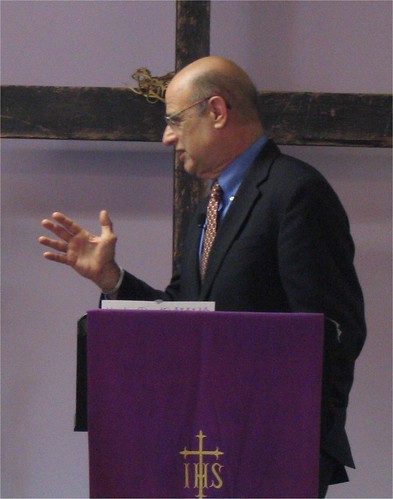
Although I’ve been giving Shane Claiborne a lot of props for exposing the idols of patriotism and consumerism, I need to shift our attention to a few of his views that have dire theological consequences, primarily centering on his sacramental view of the “least of these.” Taken from the Sheep and Goats passage of Matthew 25, according to this interpretation, not only does Jesus incarnate himself in the poor, but also that his presence within them should act as a motivation for Christians to serve the underprivileged throughout the world because we are in essence serving the mystical presence of our Lord Jesus. It is not surprising that he passionately holds this belief since his two mentors, the late Mother Teresa and Tony Campolo, propagate this view throughout their speeches and writings. While Mother Teresa was alive, she insisted on the belief that the dying, cripple, unwanted and unloved are actually “Jesus” in disguise. Tony Campolo has even called for evangelicals “to develop a theology that Jesus is waiting to be encountered in the poor and the oppressed.”
Consequently, many of my (evangelical) urban ministry colleagues have answered this call because of their sacramental view, including the influential, simple-way voice of Shane Claiborne. Throughout his book Irresistible Revolution, Shane shares stories of God’s grace and mystery when serving the poor, whom he assumed was Jesus. At times, he interchanges the phrase “God’s image in the poor” to communicate the same idea. The phrase “God’s image,” can be a much better term with one major distinction. That is, the image of God in humans was severely broken by the fall, whereas Jesus Christ embodies the perfect image of God because he is God-in-the-flesh. However, because all of us humans possess a depraved, sin nature and Jesus does not, we cannot claim that the presence of Jesus somehow dwells in the poor (or all human beings), unless they have repented and believed the gospel.
Let me share a few stories that might shine some light on this issue. Over three years ago, while driving through my neighborhood, as I paused for a stop sign, a young drug-dealing “thug” on the corner pulled out his gun with a laser scope, and aimed its red dot at my forehead. With a pull of his trigger I would’ve been a dead man, but out of sheer terror my body jolted with fear, which caused him to double up with laughter allowing me to drive away. The man with the gun was not a high-level pusher we see in movies or music videos with flashy clothes, a hummer, a “crib” mansion, and an assortment of scantily clad women by his side. Rather, he was like many other young adult men in our community: jobless, desperate, a high school drop out lacking marketable skills, and most likely addicted to the substance that he was selling. In other words, he also fit the description of being poor. So that begs the question, if, as Shane Claiborne insists, the presence of Jesus mystically resides in the poor, was this drug-dealer, who threatened my life, actually Jesus in disguise? Would Jesus have terrorized me in this manner and then mocked my fearful response?
Here’s another scenario. Fifteen years ago when I was the live-in manager at a transitional homeless shelter for men, I spent some of my time connecting with homeless people living under freeway overpasses, in refrigerator boxes, and along the river. While the homeless population, especially those who are mentally ill, are most vulnerable to physical assaults on the streets, much of the public do not realize that it often occurs by the hands of other homeless individuals. Not only were several of my homeless friends victimized by other homeless people, but also I remember helping break up a fight where one street person was beating another street person half-to-death. Here’s the million dollar question. If the mystical presence of Jesus somehow resides in the least of these, was Jesus as a homeless person actually physically assaulting and beating Jesus as the other homeless person? If we believe the nice “least of these” to be Jesus, shouldn’t we believe the nasty “least of these” to be Jesus as well?
Let’s be honest with ourselves and the Biblical narrative. Sin despoiled all people and all creation, including the poor. Unfortunately, those holding to the sacramental view tend to overlook the sin nature within the “least of these.” Yes, they are vulnerable and victimized. Yes, they often have been and continue to be sinned against. Yet like the rich, the middle-class, or any other human being (however they are classified by the world), at the core of who they are, is a selfish, rebellious sin problem. When we view the least of these as the mystical presence of Jesus, we often come away with a delusional, romanticizing outlook of the poor and oppressed.
For the sacramental view of the poor to coincide with orthodoxy, the Campolos and Claibornes ought to address (from the entire Biblical story, not just the red letters) how Christ can somehow mystically reside in the unregenerate poor, especially those who are downright evil. If they don’t, their other alternative might be to swim among the murky waters of universalism.




